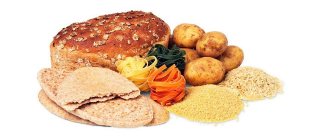Our brain is well versed in tasty foods and distinguishes between hot and cold, bitter and sweet foods thanks to special cells in the tongue - receptors. But the “gourmet” of the body – the digestive system – “knows a lot” about light and heavy foods. As you understand, heavy food is not the weight of the portion on the plate, but something else.
The first and main sign of heavy food is high calorie content.
It should be noted that the calorie content of food depends on the chemical composition, and not on the recipe for preparing the dish. For example, 100 grams of walnuts contain more than 600 kilocalories, and a 100-gram donut contains about 350.
Heavy food
All products of animal origin are considered heavy food:
- meat;
- salo;
- dairy products.
The list is supplemented by:
- sugar;
- flour products;
- chocolate;
- sweet carbonated drinks;
- bananas;
- potato;
- grape.
Unfortunately, all the “delicacies” invented by chefs are, in most cases, heavy food.
Slow digestion in the stomach and small intestine is the second sign of heavy food.
The method of preparation matters. Just imagine - ordinary chicken eggs, depending on the cooking method, can be either heavy or light food. A heavy food option is scrambled eggs, a light option is soft-boiled eggs.
Food that is hard, salty, spicy and fatty is difficult to digest.
Product groups by digestibility time
All products can be divided into four groups according to the duration of their processing by the stomach. How long does it take to digest what we eat?
Group 1. This includes mainly carbohydrates, processing time: 30-35 minutes. These are broths, light salads, natural juices, as well as fresh (raw) vegetables and fruits.
Group 2. This category contains proteins and some fats, processing time: 1-2 hours. This group includes eggs, milk, poultry, lean fish and seafood.
Group 3. These are products containing starch and complex carbohydrates, processing time: 2-3 hours. This includes nuts, legumes, cottage cheese, hard cheese, potatoes and cereals.
Group 4. This list includes foods that take longer to digest than others or are not digested at all. This includes coffee, canned food, stewed meat, mushrooms, bread and pasta.
Table of digestion times for individual foods in the stomach
| Food | Digestion time (min) |
| juice (from fruits or vegetables) | 15-20 |
| vegetables and fruits | 20-40 |
| vegetables that contain starch | 60-90 |
| egg | 45 |
| porridge | 120 |
| dairy | 120 |
| nuts and seeds | 180 |
| fish dishes | 60 |
| poultry meat | 150-180 |
| animal meat | 4-6 hours |
| mushrooms | 5 o'clock |
The table shows that the body digests carbohydrates the fastest. Next in ascending order are proteins and fats.
Important! Water without impurities does not need to be digested. It passes almost immediately into the intestines, which takes 10-15 minutes. In addition, it is an important component of our body, because every cell in the body consists of 80% water.
In addition to the types of foods, other factors also play an important role in the speed of digestion.
Light food
In contrast to heavy food, light food contains few calories and, accordingly, is easily and quickly digested. On the "easy list":
- zucchini;
- carrot;
- cucumbers;
- beet;
- currant;
- raspberries;
- citrus.
...and besides them:
- vegetable or meat puree soups;
- boiled meat or fish;
- steamed vegetables;
- fish and meat;
- vegetable purees;
- casseroles;
- well-cooked porridge;
- jelly;
- low-fat cottage cheese;
- sugar-free mousses.
Light food promotes mental work, heavy food will provide you with energy longer during physical activity.
"East is a delicate matter!" Tibetan sages believe that a skillful combination of products changes the quality of food. For example, rice is a light food, but milk is a heavy food. If milk is heated with saffron, it becomes “light”, and rice cooked in milk becomes “heavy”. You should not mix light and heavy foods in one meal, very cold and very hot dishes, food left over from previous meals and freshly prepared food.
Digestion of food in the human stomach: how does the digestion process occur?
When putting another piece of food into their mouth, few people think about what happens to it next. The digestion process is unique; thanks to it, food is processed into microelements necessary for the normal functioning of body cells.
- The first effect on the product is exerted by the enzyme amylase, present in the saliva in the mouth.
- After swallowing, the digestive juice, which secretes special enzymes, is “engaged” in breaking down the chewed pieces. Under its influence, food breaks down into proteins, fats and carbohydrates, which move through peristalsis into the duodenum.
- Here, the resulting microelements are absorbed into the blood, with further delivery to the cells of the body.
- The small intestine separates beneficial food components from waste products. The latter move into the large intestine, where they remain for up to 20 hours, followed by excretion through the rectum.
The discipline of nutrition is based on the scientific eating of foods. Mixing foods of different durations in the stomach can provoke stagnation or fermentation, resulting in: nausea, vomiting, constipation, diarrhea, bloating. The proper functioning of the gastrointestinal tract does not disrupt natural metabolism, as a result – a healthy body and no problems with excess weight.
Time for complete digestion of food in the human stomach by product category
Anyone who is familiar with the rules of separate nutrition knows that products are conventionally divided into the following categories.
- Carbohydrates. This includes vegetables, various juices, cereals, honey, potatoes, fruits, berries. They are quickly absorbed and do not stay in the stomach for more than 1 hour. The stomach will need more time to digest complex carbohydrates – up to 3 hours. For more information about foods that are complex carbohydrates and their benefits, read the article: Complex carbohydrates.
- Protein. These are dairy products, lean meats of various types, fish, eggs, legumes. To process them, the gastrointestinal tract will have to spend 2-4 hours.
- Fatty (high in fat). They are divided into two subgroups: - vegetable: nuts, avocados, vegetable oil; - animals: fatty fish and meat, lard, butter. It takes the stomach up to 6–8 hours to digest fats.
- Partially digestible or completely indigestible. They go in “transit” through the gastrointestinal tract.
Digestion time of food in the human stomach: table
Digestion time table for carbohydrate foods
| Vegetables | Time (hour) | Fruits | Time (hour) | Berries | Time (hour) |
| Radish | 0,4 | Persimmon | 1 | Sea buckthorn | 0,4 |
| Puree | 2 | Orange | 0,5 | Cherry | 0,4 |
| Fried potatoes | 2,5 | Grape | 1 | Strawberry | 0,3 |
| Fresh carrots | 1 | Peach | 0,4 | Currant | 0,4 |
| Eggplant | 3,5 | Apricots | 0,4 | Gooseberry | 0,5 |
| Fresh cabbage | 0,4 | Pear | 0,5 | Raspberries | 0,4 |
| Sauerkraut | 3 | Apple | 0,5 | Cherries | 0,4 |
| Cooked beets | 1 | Kiwi | 0,3 | Watermelon | 0,3 |
| Tomatoes | 0,3 | Banana | 1 | Greenery | |
| cucumbers | 0,3 | A pineapple | 1 | Lettuce leaves | 0,3 |
| Pepper | 0,4 | Mango | 2 | Onion, dill | 0,3 |
| Boiled corn | 1 | Prunes | 3 | Parsley | 0,4 |
| Melons | 0,5 | Dates | 2 | Spinach | 0,3 |
Heavy foods include mushrooms (digested in 5-6 hours) and melons (digested in up to 8 hours).
How long does it take to digest fast carbohydrates, cereals and liquids?
| Liquid | Time watch) | Porridge (cereals) | Time watch) | Fast carbohydrates | Time watch) |
| Water | straightaway | Rice | 2 | Cake | 5 |
| Juice (fruit) | 0,2 | Buckwheat | 1 | Waffles | 2 |
| Vegetable smoothie | 0,2 | With millet | 1,5 | Chocolate | 2 |
| Compote | 0,3 | Corn | 1 | Cheesecakes | 3 |
| Vegetable broth | 0,3 | Pearl barley | 2 | Marmalade | 2 |
| Kvass | 0,4 | Manna | 3 | Gingerbread | 2,5 |
| Chicken bouillon | 0,4 | Oatmeal | 1 | Pasta | 3 |
| Meat broth | 1 | Gray bread | 3,5 | Honey | 1,5 |
If water is consumed on an empty stomach, it is absorbed immediately.
Protein digestion time: table
| Fermented milk | Time (hour) | Meat and fish | Time (hour) | Others | Time (hour) |
| Kefir | 1 | Chick | 1,5 | Hard boiled egg | 2,5 |
| Sweet curd | 2 | Turkey | 2 | Omelette | 3 |
| Cheese | 5 | Veal | 3 | Protein | 0,3 |
| Cottage cheese whey | 1 | Duck | 3 | Yolk | 0,5 |
| Yogurt | 1,5 | Mutton | 4 | Sausages | 3 |
| Ryazhenka | 2,5 | Offal | 2,5 | Sausages | 3,5 |
| Milk | 2 | Lean pork | 5 | Beans | 3 |
| Cottage cheese | 1-1,5 | Fish | 1 | Beans | 2 |
| Brynza | 1,5 | Seafood | 2,5 | Peas | 2 |
It is not advisable to mix milk with other products. For example, tea or coffee with milk will take up to 24 hours to digest.
Time of absorption of fats in the human body: table
| Vegetable | Time (hour) | Animals | Time (hour) |
| Nuts | 3 | Lard | 6 |
| Peanut | 2,5 | Cream | 4 |
| Seeds | 2 | Butter | 5 |
Canned food is partially digested. Chewing gum passes through the gastrointestinal tract in transit.
Digestion of food in the human stomach: how and where are proteins, fats and carbohydrates absorbed?
The absorption of proteins is influenced by their origin: animal or plant. Pepsin, present in hydrochloric acid, dilutes proteins as much as possible for their further transformation in the small intestine.
The stomach cannot deal with fatty foods due to the lack of special enzymes. Acid only destroys the structure of fats, turning the pieces into mush, which, if possible, breaks down into components along the way to the large intestine.
What determines the duration of the food digestion process?
- Fruits, berries, and vegetables are easily converted into carbohydrates in their raw form . Cereals must be heat treated.
- Protein foods should be eaten warm after cooking. Hot food stays in the stomach longer than cold food.
- The stomach cannot digest heavy cold food to the desired state , sending pieces to the small intestine, which provokes stagnation of undigested proteins, leading to the proliferation of bacteria, fermentation, and discomfort.
How to help the stomach quickly digest food: what contributes to good digestion?
- Food well crushed in the mouth is absorbed faster than swallowed pieces.
- Products from the same category will be digested quickly. One meal should contain food that is digested by the stomach at the same time.
- There should be at least three hours between meals.
- You should not drink water during meals, as it dilutes the acidity level, which slows down digestion. You need to drink before meals, not after.
- Milk curdles when exposed to acid. It should not be used with other products. It can clog a piece of food in a coagulated coma, which can cause food to rot.
- A productive time for peristalsis is lunch. At this meal you can eat the longest digestible foods.
Video: How long does it take for food to be digested in the human body?
When composing your diet, take into account the time it takes for food to be digested in the stomach. Eat right and be healthy!
Do you need a diet?
“War, war, but lunch is on schedule!” - said the King of Prussia, Frederick Welhelm the First, and he was absolutely right!
It will be easier for your digestive system if you eat at the same time every day. By the time of the meal, the required amount of gastric, pancreatic juice and bile will be produced.
Higher calorie foods should be eaten in the first half of the day in order to stock up on the necessary energy, and for dinner, nutritionists recommend lighter meals.
The theoretical part of the article is finished. It's time to move on to practice. But in practice, for many of us, everything is different. Rushing to work, we don’t have time to have breakfast, we snack on cookies or a hot dog during the lunch break, and in the evening we “have a blast.” The result is indigestion, bloating, heartburn, constipation.
And who among us is able to refuse a picnic and exchange vegetable puree soup for aromatic kebab? That's the same! When you feel a piece of juicy meat roasted over an open fire in your mouth, you, by and large, don’t care that kebab is heavy food!










